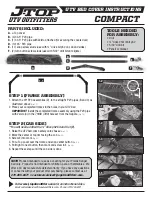
Do
k.
/R
ev
.-
N
r. 1
957
87
_2
01
80
11
7
A
6
5
4
3
2
1
7
8
9
10
11
12
13
B
6
5
13
C
11
12
13
D
2 mm max.
7
11
8
E
14
10
11
F
11
1
G
5
1
H
User
Manual
ID: #07177
m
yha
nsecontrol.
co
m
CER
TIFIED
User-friendly
Manual
DISTRIBUTED BY:
ALDI INC., BATAVIA, IL 60510
WWW.ALDI.US
USA
MODEL:
22967
866-558-8096
AFTER SALES SUPPORT
USA
95698
05/2018
WIRELESS BICYCLE
COMPUTER
YEAR
WARRANTY
3
General information
Reading and storing the
user manual
This user manual ac-
companies this wireless
solar bicycle computer.
It contains important
information about
start-up and use.
Before using the bicycle comput-
er, read the user manual carefully.
This particularly applies to the
safety instructions. Failure to fol-
low this user manual may result
in severe injury, or damage to the
bicycle computer. Store the user
manual for further use. If you pass
the bicycle computer on to third
parties, please be absolutely sure
to include this user manual.
Explanation of symbols
The following symbols and signal
words are used in this user man-
ual, on the bicycle computer or on
the packaging.
WARNING!
This signal symbol/word desig-
nates a hazard with moderate
degree of risk which may lead
to death or severe injury if not
avoided.
NOTICE!
This signal word warns against
potential damages to property.
This symbol pro-
vides you with use-
ful supplementary
information about
assembly or use.
FCC Conformity
This bicycle computer complies
with part 15 of the FCC rules. Op-
eration is subject to the following
two conditions: (1) This device
may not cause harmful interfer-
ence, and (2) this device must
accept any interference received,
including interference that may
cause undesired operation.
Please take attention that chang-
es or modification not expressly
approved by the party responsi-
ble for compliance could void the
user’s authority to operate the
equipment.
The operating frequency is be-
tween 120 kHz and 125 kHz.
Safety
Proper use
The bicycle computer is designed
exclusively for displaying and col-
lecting information when using
a bicycle. It is only intended for
private use and not suitable for
commercial purposes.
Only use the bicycle computer
as described in this user manu-
al. Using it in any other way is
deemed improper and may result
in damage to property or even
personal injury. The bicycle com-
puter is not a children’s toy.
The manufacturer or vendor
accepts no liability for damage
caused by improper or incorrect
use.
Package contents/
device parts
1
Bicycle computer (example)
2
Display
3
Right button
4
Left button
5
Bicycle computer mounting
bracket
6
Rubber pad (bicycle
computer)
7
Magnet
8
Magnet holder
9
CR2016 battery
10
CR2032 battery
11
Sensor
12
Rubber pad (sensor)
13
Cable ties, 6×
14
Battery compartment cover
Safety instructions
WARNING!
Danger for children and per-
sons with impaired physical,
sensory or mental capaci-
ties (e.g. partially disabled
persons, older persons with
reduced physical and mental
capacities) or lack of experi-
ence and knowledge (e.g.
older children).
− This bicycle computer may
be used by children ages
eight and over as well as
persons with impaired
physical, sensory or
mental capacities or those
lacking experience and
knowledge, if they are
supervised or have been
instructed in how to safely
use the bicycle computer
and understand the risks
associated with operating
it. Children must not play
with the bicycle computer.
Cleaning and user mainte-
nance must not be per-
formed by unsupervised
children.
− Keep children under eight
years of age away from the
bicycle computer.
WARNING!
Danger of suffocation!
The bicycle computer contains
small parts. Children could
swallow them when playing
and choke.
− Keep small parts away from
children.
WARNING!
Battery hazards!
The bicycle computer and the
sensor each contain a battery.
Improper handling of the bat-
teries may result in explosion or
serious internal injury.
− Store both new and used
batteries so that they are
not accessible to children.
− If you suspect that a battery
has been swallowed or
otherwise incorporated,
promptly consult a physi-
cian.
− Only replace the batteries
with the same battery type.
− Do not touch leaky bat-
teries. If you do come into
contact with battery acid,
wash the affected area
thoroughly and rinse it with
plenty of water. If leaked
battery acid comes into
contact with your eyes or
causes skin irritation, also
seek medical attention.
− If it is no longer possible to
securely close the battery
compartment, dispose of
the bicycle computer as
described in the chapter
“Disposal”.
− Do not charge or reactivate
batteries, do not disassem-
ble them, do not throw
them in fire and do not
short circuit them.
− Dispose of batteries at your
local collection point.
NOTICE!
Risk of damage!
− Improper handling of the
bicycle computer may
result in damage to the
bicycle computer.
− You can use the bicycle
computer at ambient
temperatures between
14 °F and 122 °F (-10 °C and
+50 °C).
− Do not expose the bicycle
computer to permanent
moisture.
− Avoid dust, heat and con-
tinuous exposure to direct
sunlight.
− Never try to repair the bicy-
cle computer yourself. For
technical problems, contact
the service address indicat-
ed on the warranty card.
Information about
solar cells
This bicycle computer is equipped
with solar cells that transform
light energy into electricity. This
extends the useful life of the
battery. However, batteries are
needed for the sensor and also to
supply energy when it is dark.
Checking the bicycle
computer
1. Take the bicycle computer
1
out of the packaging.
2. Remove the protective foil
from the bicycle computer.
3. Check to make sure the bicy-
cle computer is complete and
undamaged (see
Fig. A
).
If it is not, do not use the
bicycle computer. Contact the
service address indicated on
the warranty card.
Assembly
Assembling the bicycle
computer mounting
bracket and bicycle com-
puter
1. Attach the bicycle computer
mounting bracket
5
and the
rubber pad
6
to the handle-
bar with two cable ties
13
.
There are two options:
• If you attach the bicycle com-
puter mounting bracket to the
handlebar tube, thread the
cable ties vertically from the
front (see
Fig. B, bottom
).
• If you attach the bicycle com-
puter mounting bracket to the
stem of the handlebar, thread
the cable ties horizontally
from the side
(see
Fig. B, middle
).
2. Slide the bicycle computer
1
from the front into the bicycle
computer mounting bracket
until it clicks into place
(see
Fig. G
).
3. Turn the bicycle computer so
that it is at a 90° angle to the
sensor
11
.
Assembling the sensor
and magnet
1. Attach the sensor
11
and the
rubber pad
12
to the middle
of the fork with two cable
ties
13
(see
Fig. C
).
Make sure that the
bicycle computer
and the sensor are
at a 90° angle to one
another. The dis-
tance between the bicycle com-
puter and the sensor should be
no more than max. 23" (60 cm)
(see
Fig. F
).
2. Unscrew the magnet
7
and
the magnet holder
8
.
3. Attach the magnet to a spoke
on the front wheel and screw
the magnet holder onto the
magnet (see
Fig. D
).
Ensure that the
magnet passes the
sensor at a distance
of approx. 0.08"
(2 mm) at the arrow
mark on the sensor (see
Fig. D
).
Start-up
Switching on the bicycle
computer
Before starting the bicycle com-
puter, a few settings must be
made.
− To switch on the bicycle com-
puter
1
, press one of the
two buttons
3
or
4
on the
bicycle computer.
Selecting kilometers/
miles
The selection for the units of
measure kilometers (KM/H) or
miles (MPH) will appear as the
first indicator.
− Press the right button
3
to
switch between the units of
measure.
− Confi rm your selection by
pressing the left button
4
.
Setting tire circumference
Necessary after new
battery insertion or
reboot.
How to determine
the tire circumference:
1. Turn the front tire valve to the
lowest position and mark the
position of the valve on the
floor.
2. Move the bicycle forward for
one front wheel revolution
until the valve has returned to
the lowest position.
3. Measure the distance covered
in inches.
This is the tire circumference.
The display shows the default
setting for a “2155” tire circumfer-
ence (=mm). The thousands digit
2 flashes. The thousands digit can
be set to either 1 or 2. The remain-
ing numbers can assume a value
between 0–9.
− Press the right button
3
until the correct number
appears.
The thousands digit is set.
− Confi rm your entry by pressing
the left button
4
.
− Repeat the steps for the hun-
dreds, tens and ones.
Setting the total distance
The display shows the default
setting for a total distance of
“00000”.
− Press the right button
3
to
increase the number by one.
− Confi rm your entry by pressing
the left button
4
.
The ones, tens, hundreds, thou-
sands and ten thousands can as-
sume a value between 0–9.
Setting the inspection
interval
The display will show the default
setting of “000.00” for the total
distance. This corresponds to the
remaining distance until the next
bike inspection.
− Press the right button
3
to increase the ones, tens or
hundreds by one.
− Confi rm your entry by pressing
the left button
4
.
Setting weight
The display will show a default
setting of “065” for weight.
− Press the right button
3
to
increase the hundreds, tens or
ones by one.
− Confi rm your entry by pressing
the left button
4
.
Setting the CO₂ savings
This function calculates the CO₂
savings. This determines how
much CO₂ would have been
produced if the journey had
been made by car rather than
by bicycle. Look in the technical
documents of your car to find its
emissions value in g/km. Or use
the default setting of 160 g/km.
The default value of “160” appears.
− Press the right button
3
to
increase the hundreds, tens or
ones by one.
− Confi rm your entry by pressing
the left button
4
.
Setting the time
The hour display flashes.
− Press the right button
3
until the correct number
appears.
The hour display is set.
− Confi rm your entry by pressing
the left button
4
.




















